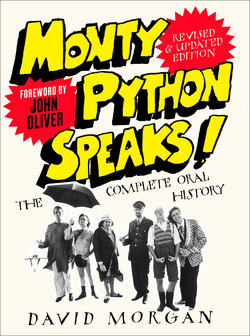Читать книгу Monty Python Speaks! Revised and Updated Edition - David Morgan - Страница 18
TAKE-OFF LET’S GET THE BACON DELIVERED
ОглавлениеAs the group prepared for the first series of Monty Python’s Flying Circus (which began recording in August 1969), the notion of applying a stream-of-consciousness style to the show’s content and execution was accepted.
PALIN: Certainly Terry Gilliam provided an example of how you could do stream-of-consciousness comedy in his animations, which he’d done on Do Not Adjust Your Set. We thought those were remarkable and a real breakthrough; there was nothing like that being done on British television. We loved the way the ideas flowed one into another.
Terry Jones was very interested in the form of the show, wanting it to be different from any other – not only should we write better material than anybody else, but we should write in a different shape from any other comedy show. And probably Terry Jones and myself saw (or were easily persuaded) that Gilliam’s way of doing animation maybe held a clue to how we could do it. It didn’t matter if sketches didn’t have a beginning or end, we could just have some bits here or there, we could do it more like a sort of collage effect. I remember that everyone was quite enthusiastic about this, but it would have almost certainly come from Terry Gilliam, Terry Jones, and myself.
GILLIAM: I think it was more like saying ‘no’ to certain things, and the first thing was ‘no’ to punchlines, which is a really critical thing. We’d seen Peter Cook and Dudley Moore doing so many really great sketches where they traditionally had to end with a zinger, and the zinger was never as good as the sketch. The sketch was about two characters, so in a sense it was more character-driven than plot-driven, [but] time and time again you’d see these really great sketches that would die at the end – they wouldn’t die, but they just wouldn’t end better [than] or as well as the middle bits. So very early on we made a decision to get rid of punchlines. And then Terry Jones was besotted with this cartoon I had done, ‘Beware of Elephants’, [in which] things flowed in a much more stream-of-consciousness way. Terry thought that was the shape that we should be playing with.
Spike Milligan had been doing some amazing things just before; his Q series in a sense really freed it up, playing with the medium of television, admitting to it being television, and commenting on that. We just continued to do even more of that than he had done, but once we agreed on the idea of not having to end sketches, and having things linked and flowing, it allowed us to get out of a sketch when it was at its peak, when it was really still good; we would laugh when it was funny and it would move on when it wasn’t funny. That also immediately made a place for me; it sat me in the middle, connecting things.
IDLE: We were young, and doing a show we would be in charge of for the first time. There were no executives. This freedom allowed us to experiment without having to say what we were trying to do – indeed, we didn’t have a clue what we were trying to do except please ourselves. This was the leitmotiv: if it made us laugh, it was in; if it didn’t, we sold it to other shows.
